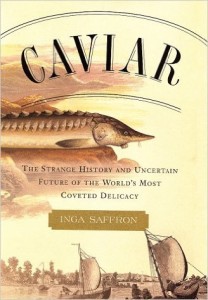 Caviar is not just about the taste. Those glistening black globules are a culinary Rorschach that unleashes our deeply held notions about wealth, luxury and life. — Inga Saffron
Caviar is not just about the taste. Those glistening black globules are a culinary Rorschach that unleashes our deeply held notions about wealth, luxury and life. — Inga Saffron
Being married to a culinary expert par excellence means that we collect more cookbooks and culinary histories than possibly one should. She insisted I review this book when she saw it in the mail room at our office, and how could I say no to such a lovely lass? Well, I didn’t. And that’s how I came to know more about these subjects than, well, I even learned about about Mother Russia from Orlando Figes’ Natasha’s Dance: A Cultural History of Russia.
Caviar is salted fish eggs. If that causes you to get a bit ill-feeling, leave now before I discuss them. Go have some porridge in the kitchen. Now, whoever’s still here should pay attention, as this is an interesting tale. And I like caviar — particularly with chilled vodka that’s served in very small glasses, so that one gets quite smashed without knowing that one’s getting smashed.
There’s Russian caviar (Beluga, Osetra, Sevruga), Iranian caviar (Beluga, Osetra, Sevruga), and American caviar (White Sturgeon, Montana Golden Whitefish, Yellowstone River Paddlefish, Chum Salmon), but the finest caviars are Iranian and Russian. I hear that the American caviars are becoming accepted these days by most gourmets, but not all. I found this comment online: ‘true caviar comes from the icy waters of the Caspian Sea where the environment is most conducive to producing the finest sturgeon. Ninety-five percent of the caviar produced in the world comes from the Caspian Sea. Only three sturgeon species produce this caviar: Beluga, Osetra, and Sevruga. Caviar is considered one of the most exquisite delicacies of the world.’
Now keeping in mind that we are, ahem, discussing salted fish eggs, why are they considered such a culinary treat that folks pay hundreds of dollars an ounce for them? You can get an ounce of caviar made from the almost extinct Russian Beluga sturgeon for around a hundred pounds if you’re lucky. If you are bargain hunting, you can get the caviar from the white sturgeon for only fifty pounds an ounce. Hell, you can buy caviar in a squeeze tube!
Which is where Caviar: The Strange History and Uncertain Future of the World’s Most Coveted Delicacy enters this tale. Inga Saffron was the Moscow correspondent for the Philadelphia Inquirer from 1994 to 1998. Saffron traveled throughout the former Soviet Union, reporting on those chaotic days after its collapse. She also acquired a taste for caviar and the other culinary delights of Russia. (She’s now the paper’s architecture critic, proving that papers do strange things with their staffs!) Here she tells a great tale of how a peasant food became a czar’s gourmet indulgence. Needless to say, she drank more vodka and consumed more caviar than most of us will ever see. Though there was that time that Brigid and I were honoured guests at the Winter Court in St. Petersburg…. When else would we have a chance to wear fur overcoats, leather boots, beaver hats, and dress to the nines? Not to mention the parties! Brigid, my wife, wore black and only black while in that city — an amazing sight with her red hair, green eyes, and pale skin. ‘Twas enough to stir the blood of the most jaded male. But I digress…
What Saffron does most excellently in Caviar is chronicle the sturgeon roe’s rise from being something only Russian peasants considered food to a coveted and very costly (in all senses) delicacy to be consumed only by the wealthy and privileged. The book also explores how the collapse of the Soviet Union meant the sudden accessibility of caviar to a growing middle class, which in turn rather quickly led to the rise of poaching and the decline and possible extinction of the sturgeon population. (As mentioned above, other fish are used for caviar, but only these fish are considered the source of true caviar by fanciers.)
Saffron, an obvious fanatical lover of caviar, writes with a passion that is as strong as her love. She takes the eating of salted sturgeon eggs to what one person noted is ‘an almost spiritual level.’ The bottom line here is that, if you eat caviar, this book will give you a much deeper appreciation of the nibblet that you just spent many quid on. If you don’t eat caviar, why are you reading this review? Now excuse me, as a tin of beluga caviar and a bottle of Stolichnaya Cristall vodka are calling me…
(Broadway Books, 2002)
